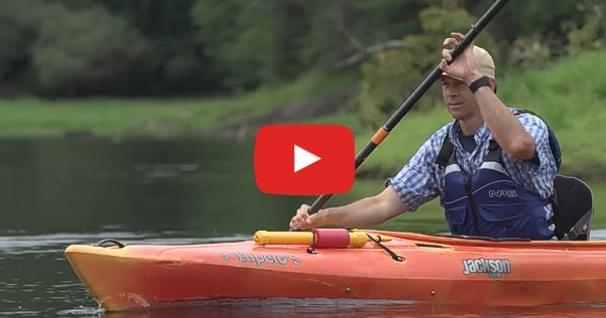Overview of the Kayak Balance Brace
Watch this video that demonstrates the usefulness of learning the balance brace. This brace is an integral part of the layback or sweep roll, and can help tremendously in improving your rolling technique.
A question I get often is on the Balance Brace. What is it for? Is it useful? Is it hard to do? And the answer is: it's definitely easier to do in some kayaks than others, but essentially it's the equivalent of the dead man's float when you're swimming. It's finding that balance where the kayak is sitting on its side and it does not want to collapse on top of you, because you have found that perfect position when you're out on the side on the water, where you can float. You're essentially cancelling out the kayak wanting to come and collapse on top of your body. Here's just a basic overview of how to do it. I would recommend doing it with someone else unless you have a solid roll. If you have a solid roll, no big deal because every time you go down, roll back up, and try again.
So where is the Balance Brace useful? If you're working on lay back rolls, the Balance Brace is pretty much the same motion that you will use with every single roll, and that goes from a lay back roll all the way to a hand roll. As you get better on your Balance Brace, you will depend less and less on your paddle, as you go for that sweep, and laying back onto the back of the kayak.
So the easiest way to get into the Balance Brace is by first, laying flat on the back deck of your kayak, spread your arms, and then slide yourself out into the water. Try to be as perpendicular to the kayak as you can, while twisting your torso and keeping both shoulders as flat on the water as you can. This is key. Arch your back, tilt your head back. It's okay if the water covers your face at first. As you get better at this, your face will come out more and more out of the water. You can use anything to assist you at first. So it could be a paddle float, it could be your paddle. Eventually try to move down to smaller objects and to let go of the paddle. Depending on what side you're on, that leg will have to be engaged while the other one will be relaxed. That will try to keep the kayak from collapsing on you. At the same time, some people will have to get their butts out of the seat slightly, others can stay in it. It depends on how flexible you are. When you're ready, make your way out of the water onto the back deck again staying as flat as you can, and then you can sit up.
A really good exercise (Tracy Coon taught me this one), is if you set up for a butterfly roll before you come out of the water, once you open up, try to go into that Balance Brace instead. Hang out there for a little while, and then get out of the water. That breaks it down step-by-step so that you are making sure that when you go into the Balance Brace, you're going into the full correct position before getting out of the water. A lot of times when you're rolling, everything happens so quickly, you can't really tell what's going on. It's very good for technique in lay back rolls to make sure there's a really good-looking Balance Brace in the middle of that roll. And the more you do that, the less assistance you will need on your paddle.
So as always, I hope that was helpful. These are not perfect answers. These are just tips and things that I've gathered from my experience paddling with other instructors, paddling with other paddlers. Hopefully, they will help you along the way.
Thanks to the "Kayak Hipster" (Luke Rovner) for use of this video!
Luke is a sea kayak instructor, with a focus on rolling and traditional paddling. He combined his experience as a photo and video
professional with his love of kayaking and started Kayak Hipster, with the goal of capturing outdoor adventures and sharing kayaking tips.
Website: http://kayakhipster.com
Related Articles
Even though they are flipping over, missing their gates and failing their maneuvers, they still look…
In this video, we're going to look at five kayaking tips that will help make you a better paddler, or…
For obvious reasons, the forward stroke is the most important stroke to learn. But you don't need to…
As a member of the US Surf Kayaking Team I had the honor and privilege to compete in the world…



